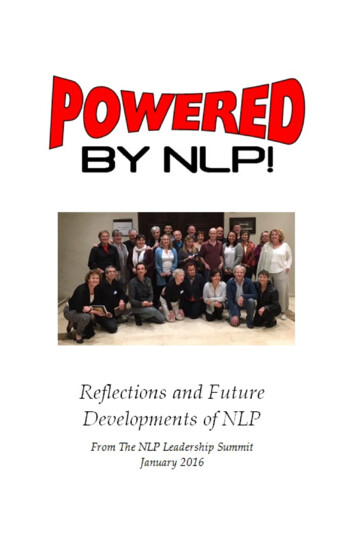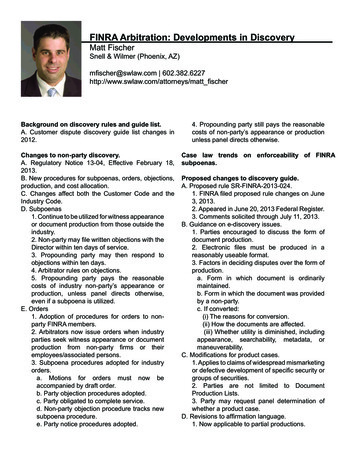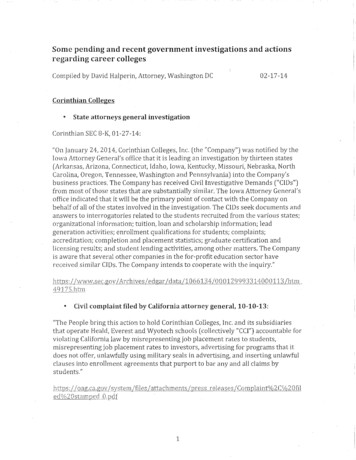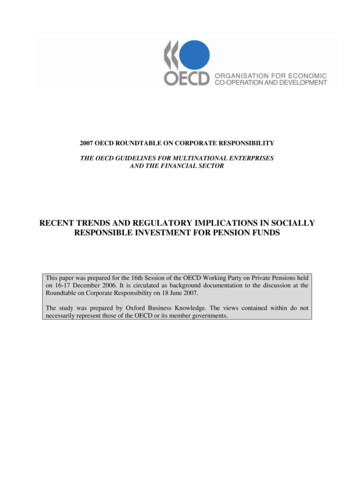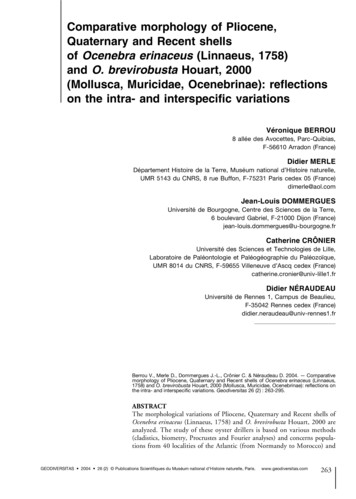
Transcription
J Syst Sci Syst Eng (Jun 2012) 21(2): 129-143DOI: 10.1007/s11518-012-5190-5ISSN: 1004-3756 (Paper) 1861-9576 (Online)CN11-2983/NPROJECT MANAGEMENT: RECENT DEVELOPMENTS AND RESEARCHOPPORTUNITIESNicholas G. HALLDepartment of Management Sciences Fisher College of Business, The Ohio State University, USAhall 33@fisher.osu.edu ( )AbstractThis paper studies the business process known as project management. This process has exhibited aremarkable growth in business interest over the last 15 years, as demonstrated by a 1000% increase inmembership in the Project Management Institute since 1996. This growth is largely attributable to theemergence of many new diverse business applications that can be successfully managed as projects.The new applications for project management include IT implementations, research and development,new product and service development, corporate change management, and software development. Thecharacteristics of modern projects are typically very different from those of traditional projects such asconstruction and engineering, which necessitates the development of new project managementtechniques. We discuss these recent practical developments. The history of project managementmethodology is reviewed, from CPM and PERT to the influential modern directions of critical chainproject management and agile methods. We identify one important application area for futuremethodological change as new product and service development. A list of specific research topicswithin project management is discussed. The conclusions suggest the existence of significant researchopportunities within project management.Keywords: Project management, overview, recent practical developments, opportunities for research1. IntroductionA project is conventionally defined as a“temporary endeavor undertaken to create aunique product or service” (Project ManagementInstitute 2008). Alternatively, a project can bethought of as a well defined set of tasks thatmust all be completed in order to meet theproject's goals (Klastorin 2004). In a typicalproject, many tasks are performed concurrentlywith each other. Another key feature of projectsis the existence of precedence relations betweenthe tasks. These relations typically defineconstraints that require one task to be completedbefore another starts.Compared to many business processes,project management appears to be particularlydifficult, from both theoretical and practicalperspectives. From a theoretical perspective, thefundamental planning problem of resourceconstrained scheduling is highly intractable.From a practical perspective, the two standardobjectives in project management are defined to Systems Engineering Society of China & Springer-Verlag Berlin Heidelberg 2012
130Hall: Project Management: Recent Developments and Research OpportunitiesJ Syst Sci Syst Engbe completion of the project on time and onbudget. Yet, many projects fail to meet these twocriteria, despite detailed planning beforeexecution begins and the use of modern projectmanagement software. Further, the failure rate ofprojects is higher in many modern applicationsthan in traditional ones, due to less reliable dataand the more challenging characteristics that arediscussed in Section 2 below. Indeed, it can besaid that, despite its recent massive growth inuse, project management is a difficult to managebusiness process. As we discuss, this is creatingextremely interesting research opportunities. Thepurposes of this work are to outline what thoseopportunities are, and to provide some specificexamples.This paper is organized as follows. InSection 2, we provide a brief history of projectmanagement, document its dramatic recentgrowth, and discuss the new challengespresented by its greatly expanded set ofapplications. Section 3 summarizes thedevelopment of methodology for projectmanagement over time, from familiar techniquesdeveloped in the 1950s to more recent andnewly influential ideas. In Section 4, we identifymany specific research opportunities in projectmanagement. Section 5 provides a conclusion.2. History and GrowthThe use of project management as a businessprocess goes back a long time. Indeed, thebuilding of the Egyptian pyramids is believed bymany to have been assisted by the use of simpleproject management principles. For much of thehistory of project management, the predominantapplication type was engineering andconstruction projects - for example, roads,bridges and skyscrapers. This was still the casewhen project management became formalized inthe 1960s with the help of new computing power.A particularly impressive project managementachievement at that time was the Apollo moonlanding project (1961-1969), which required thecoordination of about 410,000 workers at a costof 25 billion in 1961 dollars, or 154 billion in2011. Another impressive achievement is theorganization of the Olympic Games usingproject management. This is an example of anevent project, where the project deadline is fixedand cannot be violated.These successes were achieved for a fairlynarrow range of applications. However, thepotential for project management to be appliedto a much wider set of applications graduallybecame apparent. Important modern applicationsinclude implementing a new IT system, ls), the management of strategicorganizational change, new product and servicedevelopment, and software development.However, traditional and modern projectsoften have very different characteristics. First,the eventual configuration of traditional projectsis much more transparent than for modernprojects. For example, construction of a bridgeor skyscraper typically does not start until verydetailed blueprints have been drawn up. We saythat such project management applications aredeterministic. By contrast, the exact drugformula to be used in a new pharmaceutical istypically not known until late in the project, as aresult of testing and regulatory approval.Similarly, the exact configuration of a softwarecode is not known until its last line is written.We say that such project management
Hall: Project Management: Recent Developments and Research OpportunitiesJ Syst Sci Syst , the processes of scheduling andbudgeting the project are considerably moredifficult for nondeterministic projects than fordeterministic ones. A second distinction lies inthe difficulty of estimating the amount of workthat has been completed so far. While a roughestimate is visually available in the case of askyscraper, it is typically not available in thecase of a software program. This lack oftransparency about project progress makes itdifficult to estimate time and cost variancerelative to project progress, and without thisinformation is it difficult to allocate resourcesthat protect the performance of the projectrelative to its overall schedule and budget. Athird defining difference lies in the time pressureunder which projects are completed. By theirnature, traditional projects are often of lengthyduration, whereas modern projects can be muchshorter, especially for new products and services.With short product and service life cycles, forexample as in the consumer electronics industry,a delay in project completion can mean that aproduct is simply uncompetitive.In all the three examples considered above,the characteristics of modern projects makethem substantially harder to manage, andespecially to complete on time and on budget,than traditional projects. As discussed in Section3 below, this has resulted in the development ofnew,alternativeprojectmanagementmethodologies that can more effectively dealwith the difficulties of modern projects.Several reasons can be identified for theincreasing importance of project management asa business process. Principal among thesereasons are the following.1311.Project management effectively controlschange,allowingorganizationstointroduce new products, processes andprograms.2. Projects are becoming more complex,making them more difficult to controlwithout a formal management structure.3. Projects with substantially differentcharacteristics, especially in IT, areemerging.4. Project management helps cross-functionalteams to become more effective.5. Companies are using project managementto develop and test their future leaders.The dominant professional organization thatsupports project management is the ProjectManagement Institute, which operates branchesin 180 countries. This organization had aworldwide membership of less than 10,000 in1980, but this grew substantially to about 50,000by 1996. Today, PMI has about 550,000members. There are few, if any, other businessprocesses that can demonstrate three consecutivedecades of exponential growth in interest, orsuch a large professional interest level today.The rapid growth in project managementapplications has also created bottlenecks in thejob market. For example, in summer 2010, therewere 10,000 unfilled jobs in IT projectmanagement in Asia alone.3. Development of MethodologyAlthough project management was not yetformalized as a business process at the time, asignificant development occurred in 1917 whenHenry L. Gantt (1861-1919) invented the Ganttchart. This chart keeps track of the progress oftasks and the allocation of resources to them
132Hall: Project Management: Recent Developments and Research OpportunitiesJ Syst Sci Syst Engover time, and is the central tool for nt software.The critical path method was developed byDuPont Company in the late 1950s. This methodplans projects without considering eitherresources or uncertainty in task times. Thesesimplifications permit the use of a simplealgorithm that delivers optimal solutions.Several project management software packages,including the market leader Microsoft Project,also use this method as a key step in developingsolutions.In order to model the effect of uncertainty intask times, the consulting firm Booz AllenHamilton developed the Program Evaluation andReview Technique (PERT), also in the late1950s. This technique enables estimation of theimpact of uncertainty in individual task times onthe uncertain duration of the overall project.PERT is still used today in many companies.However, PERT relies on several strongstatistical assumptions that are difficult to justifyfor most projects. As a consequence, the projectduration estimates obtained from PERT are oftenunreliable and on average substantially biasedtowards the low side. Schonberger (1981)documents these problems. Many companiesdevelop their own adjustment factors to accountfor the bias in PERT, but these factors aredifficult to estimate robustly.An alternative to PERT is Monte Carlosimulation. This methodology has been appliedto project management since the 1960s, andavoids the worst problems of PERT. However, itmakes stringent requirements on available data,since it requires knowledge of a probabilitydistribution for each task time. In projectmanagement, the uniqueness of projects impliesthat such distributions are rarely available inpractice. Although they can be estimated, it isdifficult to predict the effect of choosing anincorrect distribution on the overall projectduration estimate. A further problem is thatcompanies have been reluctant to implementMonte Carlo simulation, apparently due tounfamiliarity with its statistical justifications anda possibly naive satisfaction with their existingmethodology.In recent years, there have been twosignificant methodological innovations inproject management. Critical chain projectmanagement (Goldratt 1997) was developed bythe influential consultant and business writerEliyahu M. Goldratt (1947-2011). In order toprevent the dispersion of slack time around theproject, where it may become lost due toParkinson’s Law (Parkinson 1958), slack time iscollected into specific buffers. This converts theproject management scheduling problem intoone of buffer maintenance and management.Since the availability of software, for exampleProChain, to support critical chain projectmanagement, many companies have reportedsignificantly improved project performance as aresult of using it.Finally, the notion of agile projectmanagement was first popularized by the AgileManifesto (agilemanifesto.org 2001). Agileprinciples include minimal planning anddocumentation, the submission of deliverables insmall increments to obtain user feedback, andquick response. Agile project management hasso far been influential mainly for thenondeterministic applications discussed inSection 2, especially research and development
Hall: Project Management: Recent Developments and Research OpportunitiesJ Syst Sci Syst Engand software development. However, because ithas some of the features of nondeterministicprojects, the application area of new product andservice development offers significant potentialfor future expansion (Smith 2007). A challengethat remains to be solved is the difficulty ofscaling agile methodology for large projectsoutside of the software development domain.4. Opportunities for ResearchIn this section, we describe a series ofimportantresearchtopicsforprojectmanagement, along with various associatedresearch questions. These topics are grouped asfollows. Section 4.1 considers projectmanagement under uncertainty, Section 4.2considers contractual issues in projectmanagement, and Section 4.3 considers otheremerging topics.4.1 Project Management underUncertainty4.1.1 Robust Optimization for ProjectSchedulingIn projects with tight deadlines, or those thatexperience delays at the execution stage, astandard technique is crashing, i.e. expediting,tasks. In practice, crashing can be accomplishedby a variety of means, for example by overtime,by the application of additional resources, or bythe subcontracting of tasks. A crashing decisiontypically represents a tradeoff between time andcost, one that can be modeled as a simple linearprogram where task times are known. Crashingdecisions become much more complex, however,when task times are uncertain. A frequentdifficulty is that the project manager does not133have an exact, or even approximate, probabilitydistribution for the times of the individual tasks.Another difficulty is that the uncertain task timesmay be correlated. For example, if the sameresources are used for two different tasks, it islikely that their performance on those tasks willshow a positive correlation. Therefore, crashingdecisions need to be made against a backgroundof substantial and complex uncertainty. Twostandard approaches that are widely used tomake crashing decisions are PERT and MonteCarlo simulation. However, PERT requiresproblematic and potentially biasing assumptions(Schonberger 1981), whereas there isconsiderable resistance among project managersto the use of Monte Carlo simulation (White &Fortune 2002).In these situations, modern robustoptimization techniques (Bertsimas & Sim 2004,Goh & Sim 2010) may be useful. Suchtechniques can be used to develop lineardecision rules that convert information that isrevealed over time into decisions. In this case,task times are revealed over time, and thatinformation is converted into crashing decisions.Because these techniques do not make strongdistributional assumptions, their performance istypically much more robust against unusual orextreme task time realizations. A related conceptthat may be useful is satisficing (Brown & Sim2009). In evaluating the complex tradeoffsbetween time, cost and risk that are required foreffective crashing decisions, satisficing modelsprovide the advantage that they do not requirethe decision maker to specify, a priori, a riskaversion parameter. Moreover, some satisficingmeasures have desirable properties thatgeneralize standard objectives, for example the
134Hall: Project Management: Recent Developments and Research OpportunitiesJ Syst Sci Syst Engmaximization of the probability of a projectmeeting its total cost, which includes bothcrashing cost and overhead based on projectcompletion time. Goh & Hall (2012) developlinear and piecewise linear decision rules, and arolling horizon approach, for a total costsatisficing model.4.1.2 Robust Optimization for ProjectSelectionBoth statistical and informal evidencesuggest that a big factor in successful projectmanagement is selection of the right projects(Cooper et al. 2000). A major justification forthis statement is that well chosen projectstypically run smoothly and are easy to manage,whereas poorly chosen projects not onlyunderperform but may hurt other projects byabsorbing their resources. There are twofundamentally different approaches to projectselection. First, projects can be selectedindividually, usually based on a quantitative andqualitative evaluation of their characteristicsrelative to predefined benchmarks. Alternatively,a project portfolio planning approach can beused to evaluate multiple projects and makesimultaneous decisions about whether to acceptthem. The portfolio planning approach is bothmore precise and more powerful, but presentsmodeling and computational challenges. Ifproject returns are known, these can beaddressed using the knapsack (Kellerer et al.2004) and related models (Fox et al. 1984,Dickinson et al. 2001). However, thesechallenges become much greater in the presenceof (a) uncertain project returns without ons, such as synergistic value, betweenproject returns, and (c) correlation betweenproject returns, for example between projects inthe same industry or locality.Several classical approaches exist forfinancial portfolio selection. These include (a)the maximization of expected return, (b) theminimizationoftheprobabilityofunderperformance relative to a given target, (c)the minimization of variance subject to meetinga target expected return (Markowitz 1959), and(d) the maximization of the safety-first ratio(Roy 1952). The work of Aumann & Serrano(2008) on riskiness indices suggests a newdirection related to target based choice.Intuitively, it should be possible to identify theleast risky project portfolio that meets a giventarget in a certainty-equivalent sense. However,modeling and identifying this portfolio presentformidable computational challenges. For thisreason, the design of a complex methodology foridentifying an optimal portfolio needs to besupported by the design of a simplermethodology that can reliably identify goodquality heuristic portfolios. Hall et al. (2011)minimize the underperformance risk of theproject portfolio, using absolute risk aversion asa criterion, and considering both correlation andinteraction effects between project returns.4.1.3 Earned Value AnalysisEarned Value Analysis (EVA), also known asearned value management, is an accounting andcontrol system for projects that was developedin 1962 as part of a U.S. Department of Defensestudy. It is based on metrics that monitor theprogress of the project, including the actual costof work performed, the budgeted cost of workscheduled (i.e., the budget), and the budgeted
Hall: Project Management: Recent Developments and Research OpportunitiesJ Syst Sci Syst Engcost of work performed, which is also known asearned value. The central idea in EVA is thatcost and time variances should be computedrelative to the progress actually completed onthe project. Despite this apparently sensiblejustification, EVA is not widely used in industryand has significant weaknesses.One major weakness is that it does notdistinguish between critical and noncriticalactivities, although time variance is clearly amore serious concern for critical activities. Arelated weakness is that EVA assumes that tasksare independent, whereas in practice they areoften dependent, and consequently variance inone task affects the performance of another.Behavioral issues also arise from the use of EVA.For example, in order to make cost variancepositive, managers may
Hall: Project Management: Recent Developments and Research Opportunities 132 J Syst Sci Syst Eng over time, and is the central tool for visualizing project progress when using project management software. The critical path method was d

